Pouteria lucuma, synonym Lucuma obovata
by Laurie Meadows
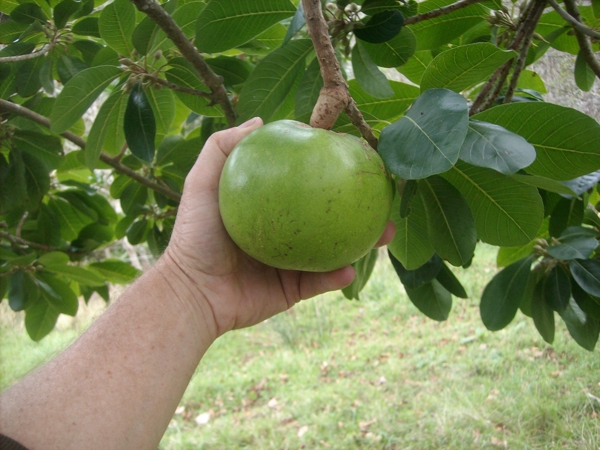
Background
A fruit of the Andes, in Chile the fruit is called lucuma, and the tree is called lucumo. In Ecuador, the tree is called lugma.[8] The native habitat of this tree is the high Andean valleys of Peru, Chile, and Ecuador. It has been used for at least 2,000 years, pre-dating even the use by the Incas. Historically, the trees have provided food in times of shortage of other crops, so can be seen as' insurance' against crop failure. It has only ever been used to any extent in South America, but there is increasing interest in the fruit as a natural ingredient. Villages in Ecuador and Peru have traditionally had one or more trees by houses or in the vicinity of the settlement, but it is not common in the marketplace. Traditional use has been as chicken feed or as baby food.[8]. This may reflect the characteristics of the local type, which is much less acceptable for fresh eating than Chilean types. Chilean fruit is sweeter, and has a more intense flavor, and as a result the fruit is more popular and more widely grown. The availability of industrially processed pulp and powder has seen its use expand to ice cream (the predominant use), yoghurt, milk shakes, cakes, biscuits, baby food, liqueurs, and so on. It seems quite versatile as a food ingredient.
Peru is the main producer for the dried pulp market, with 600 hectares in lucuma orchards as at 1999, and more plantings projected. Much is consumed domestically (400 metric tonnes were sold in Peru alone in 2012). However, montane 'informal' plantings are not counted, so production as at 2002 was estimated at vastly more 16,000 tonnes of fresh fruit in Peru alone (given 8 tonnes per hectare) [2].
In 2012, 250 metric tonnes of the pulp was exported from Peru, most of it to Chile, but such is the interest that export tonnage is expected to jump to around 500 tonnes in 2013. There are now around 200 hectares of lucuma orchard in Peru producing exclusively for the lucuma export market. The flour is also in big demand internationally, but it takes more fruit to make a kilo of flour than it does of pulp, and production is relatively limited. About 20 metric tonnes of flour was exported from Peru in 2012. A small amount of fresh fruit are exported, almost all of it to France.
Various other countries are investigating lucuma as a crop, including New Zealand, according to the Peruvian reference below [2]. In the case of New Zealand this is no longer true, as Hort+Research (the former Department of Scientific and Industrial Research) abandoned minor crops many years ago, and most of the carefully selected germplasm has been lost.
History in New Zealand
Stuart Dawes, subtropical pomologist at the DSIR introduced seed from carefully selected trees in Ecuador, Chile and Peru in 1973. I believe that most, if not all, seedlings were fruiting by 1984, at least. Seed was also introduced by Dick Endt subsequent to him seeing trees growing in Ecuador in 1977. This seed came from both Ecuador and Chile. The seedlings at the LandsEndt orchard were planted as a hedgerow for later selection of better types. They started fruiting in the early 1980's [8]. The seedlings are now (2013) fruiting well. although, as expected in a hedgerow situation, they are now rather tall. Scionwood from 3 Chilean cultivars ('Vergata', 'Merced' and 'San Patricio') were successfully established by the Endts..Currently, it is not anticipated that further work will be done on any of these trees. [Dick Endt, pers. comm 2013]
Stuart Dawes also introduced scionwood of named varieties and improved selections in 1980, as part of a co-operative plant exchange with South American countries. These cultivars were bulked up at Tharfield Nurseries in Tauranga for planting out in field trials. In total, 300 grafted trees were planted out [9]. .The fruiting selected seedlings and cultivars growing at the Pukekohe Research Station were ultimately bulldozed. Presumably if plants were established at the Te Puke and Kerikeri Research Stations they, too, would have been bulldozed. Some plants might have been distributed to co-operating orchardists for mini-trials under the 'new crops' scheme of the government of the day, but if they were, they have dropped out of sight (although there may possibly be a planting still in existence in Northland, but whether of seedlings or named cultivars is uncertain [B. King pers. comm 2014]).
Stuart Dawes sent grafted plants of the best cultivars to the Austen Brothers Exotica nursery in Kaitaia in the 1980s. The most important cultivar was considered to be a very large fruited type which but needed a warmer climate to fruit. (Some scionwood of this cultivar (whose name is now lost) was given to Auckland plant enthusiast Bernard King, and two grafted plants from this accession are still extant. Ironically, the plant at the Austen Brothers Nursery subsequently died. A plant is currently being propagated in Auckland to replace it.) [B. King pers. comm 2014]
When the DSIR abandoned minor subtropical crops, the contracting nursery (Tharfield Nurseries) on-sold either part of, or all the lucuma cultivar grafted plants (70 plants) to Lyndale Nurseries. The plants were not a priority for the nursery, and ultimately it was arranged for the trees to be planted at Shelly Beach Farms, north of Helensville. Unfortunately, feral deer jumped the fence around the planting and ate the trees to the ground. Fortunately, George Sinnock, a member of the New Zealand Tree Crops Association in Auckland, rescued scionwood of two Peruvian cultivars, 'Montalban' and 'La Molina' when the Pukekohe trees were bulldozed.[B. King pers. comm 2014
The few remaining named cultivars are currently unobtainable, although some plants of one cultivar may be available in future [B. King pers. comm 2014].
There is a cryptic note in a 1997 compilation listing some of the known plant imports of New Zealand Tree Crops Association listing "11 selections from various places by Gardner". Phil and Georgie Gardner imported many plants through their quarantine facility in the Bay of Islands, but it is unknown whether these 11 selections were cultivars imported from overseas, or propagation of DSIR cultivars imported in the 1980's.
It is a matter of great regret that the carefully selected cultivars and seed acquired at great expense by the DSIR have largely been lost; foresight and chance have resulted in a few of the cultivars remaining in existence in New Zealand, albeit tenuously. The only hope for a more secure future for these treasures is if they are propagated and sold.
This remains a rare tree in New Zealand, probably because the fruit is 'odd'. It is not crisp, it is not juicy,. It is kind of moist-powdery, but, apart from the best cultivars, not very sweet if not mature. Worst of all, it is hard to know when it is ripe. Its main use in South America is as a flavoring, in the form of a dried powder as it has a very intense butterscotch flavor. An industrial process has to be supported by large scale plantings for it to be viable, and land that could be used for lucuma in New Zealand has more potential for other, more profitable, fresh fruit crops. It's future in New Zealand is not bright.
Climate Needs
According to reference 2 (below) the trees are adapted to the climate of the Andean low mountain ranges, which experience temperatures of 8oC to 27oC. The optimum range is 14oC to 24oC, which fits well with the north Auckland climate - certainly, the trees seem well adapted to conditions here. Air frosts are extremely rare here, but the Peruvian information is that it "does not tolerate heavy frosts, and can die with temperatures below 5oC". I suspect this should be translated as death can occur if temperatures drop to minus 5oC, as night time air temperatures would get below this level from time to time in winter. This is borne out by the experiences of a Majorcan grower, who rates them about as frost tolerant as citrus. Interestingly, the Majorcan experience is that they can tolerate 40oC heat, as long as they are adequately supplied with water. [6]
Soil Needs
Peruvian information says the tree will grow across a wide range of soil types, including somewhat calcareous or even slightly saline soils, so long as the soil is fairly well drained. Most of the seedlings here have grown well in an area of tight sandy-clay. This is a very damp soil in places, and several trees have succumbed (or are slow-motion succumbing) to Phytopthora. The others are healthy.
Tree
This is a handsome tree, small to moderately tall, with slightly leathery leaves. Left to itself, it sometimes grows as a central leader tree, but more usually it has multiple leaders. While in the Andes it flowers and fruit year round, here in Auckland the trees seem to flower in mid winter to spring (in 2014, an exceptionally dry year, the trees all flowered very heavily in autumn, from march to late april). The flowers are white, and narrowly tubular. The female style projects from the bud prior to the flower opening, possibly as a means of ensuring cross pollination. The male anthers are arranged around the 'mouth' of the flower 'tube'. Presumably they can then pollinate the female part, if it hasn't already been done.
The literature says lucuma trees are self fertile, and "appear to be insect pollinated". [5] It takes about 8 or 9 months to go from flower to mature fruit [13].
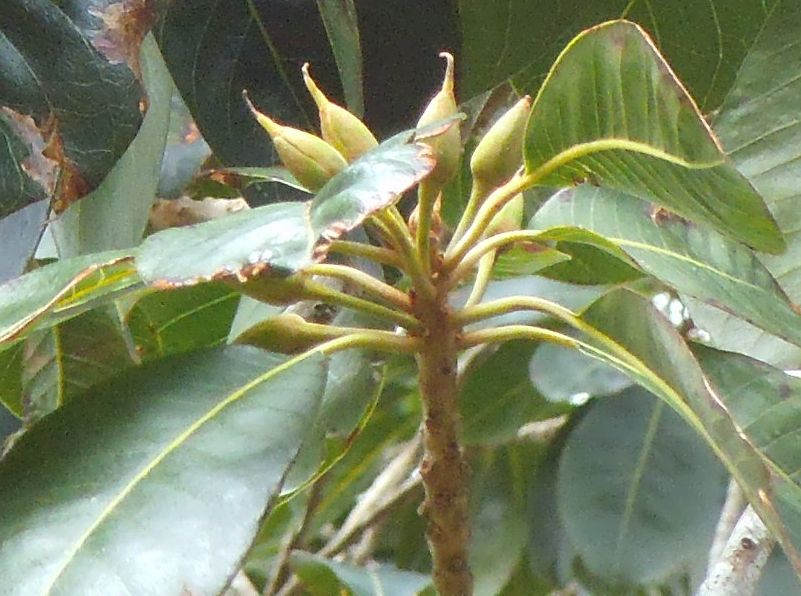
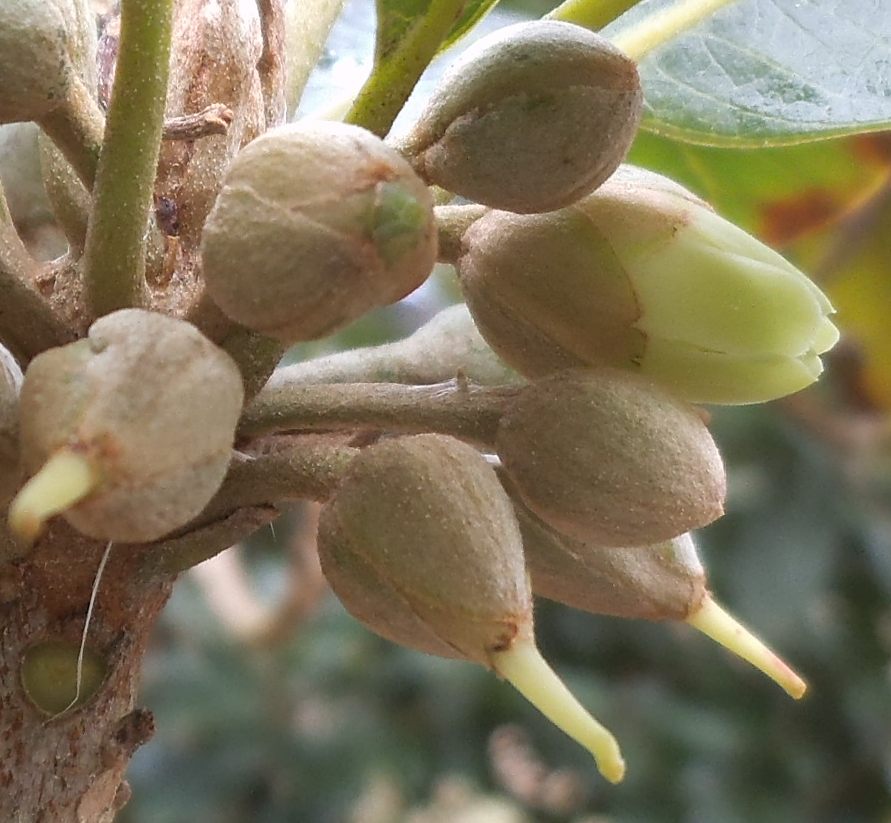
Flower buds Flower
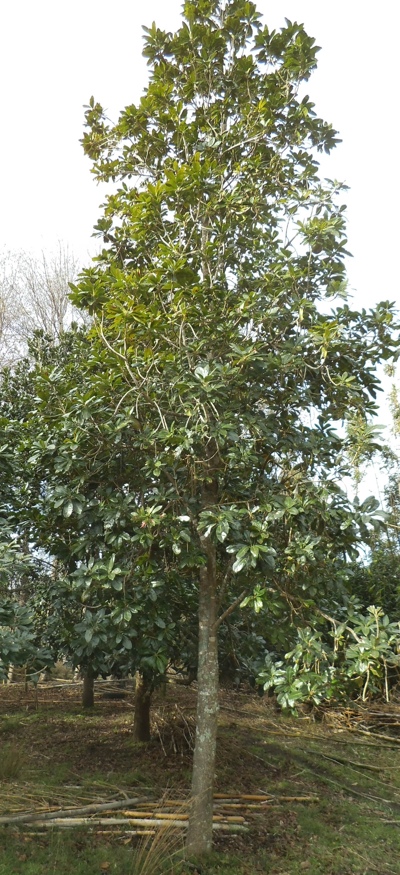
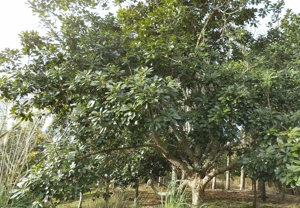
Single leader tree Multiple leader tree
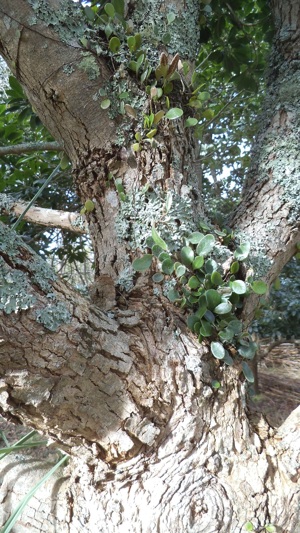
Some trees develop fissured bark with age
The trees start new terminal growth flushes about mid december here, although timing varies quite a bit between trees. Fruiting is, broadly speaking, winter
Cultivars
In Peru, over 100 improved lineages have been identified, either with heavier fruit production, or improved fruit quality. Selections have bean made by the University of Chile, and by La Molina University. It seems a very variable species, and ripe for selection (as in Peru), or deliberate breeding.
All but one of our trees are grown from seed from Ecuador, and are of the dry fleshed type.
The only cultivar I have seen for sale in New Zealand is 'La Molina', which was at one time available from a nursery in Kerikeri, Northland. It is a Peruvian cultivar, said to be of the soft flesh type, with orange flesh.
The Peruvian cultivar 'Montalban', a seda (silk) type is growing in a backyard collection in Auckland, a lucky survivor of the DSIR imports of the 1980's. Montalban is a soft flesh type, although it has only recently been released from competition with adjacent trees, it is clearly a very productive tree under Auckland conditions. Its fruit are both larger and sweeter than the other warm temperate cultivars still (just) in existence in New Zealand. Montalban appears to ripen most of its crop over about a two month period in winter. Some Montalban fruit have a tendency to develop cracks in the skin as they mature [Bernard King, pers. comm 2014].
Three cultivars, 'San Antonio', 'Merced', and 'Vergata'.are growing at LandsEndt. These are all Chilean cultivars [Dick Endt, pers. comm 2013].
La Molina, San Antonio, and Merced are inferior to Montalban when grown alongside each other. While the very large and sweet heat-requiring cultivar (name lost) exists in Bernard Kings' collection, it seems unlikely to set fruit unless provided with additional heat. [Bernard King, pers. comm 2014].
No cultivars are currently available for sale in New Zealand.
Fruit
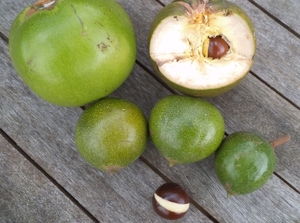
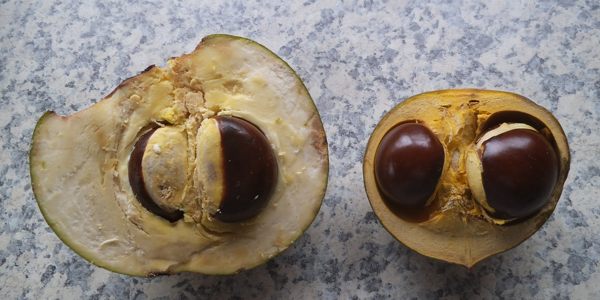
Ecuadorian large dry fruit, and Chilean small sweeter fruit. These from seedlings, so are not the best representative of the type.
There seems to be quite a bit of variability amongst lucuma fruit from different regions. The main use of the fruit historically has been for fresh eating, and as the seeds grow readily, it is fair to suppose that the better fresh eating types were accidentally spread around and their 'superior' genes concentrated locally over time, possibly displacing other forms. Possibly this was the case in Chile, in particular.
The fruit is generally large, "up to 1 kg" according to Fruitipdia. The tree with the biggest fruit here has some large fruit that weigh around 580 grams. Other trees have smaller fruit, around 350 grams. The Chilean seedling tree I have here has smaller fruit still, at around 150 - 160 grams. The fruit on the Chilean tree are conic, with a pointed end, whereas all the Ecuadorean seedlings are more or less round, but with a flattened base. The smaller fruit have 1 or 2 seeds, the larger fruit have more, up to 4. The seeds are large, with a shiny dark brown seed coat. Even so, pulp makes up 64% to 82% of the fruit [2]. Large fruit size doesn't necessarily indicate more seeds. Some 500gram fruit only have 2 seeds, for example. The thin skin is green, although some trees have fruit with yellow tan skin [2].
The flesh of the Ecuadorian seedlings is sort of 'dry' and crumbly (the texture of the yolk of a boiled egg, perhaps), slightly sweet, tasting somewhat of butterscotch (some say maple syrup), but the odd 'powdery' mouth feel and the lack of juice makes it a fruit you don't really want to eat. The pulp texture of some of the fruit here can be fairly described as almost 'dust dry' in mouth feel. These mealy, boil-egg-yolk textured, dry ones are called 'hard' or ('palo' in Spanish) types. They are sometimes classified as 'Biotype II' [12] They are not as sweet (around 18 Brix). The flesh color varies. In some seedlings it is a pallid creamy-yellow, in others it is a more pronounced yellow. Fully sized but immature fruit have whitish flesh.These drier fruit are preferred for processing into lucuma flour - presumably because they are already part way there! The 'ideal' lucuma fruit for flour would have bright orange, or at least deep yellow pulp; good levels of soluble solids; an intense aroma, and a good pulp/flour yield per fruit (a single seed would be ideal). These large Ecuadorean 'palo' fruit go some way to this ideal, but lack the required flesh color intensity and lack much in the way of sugars. The aroma is variable, but not marked.[7]
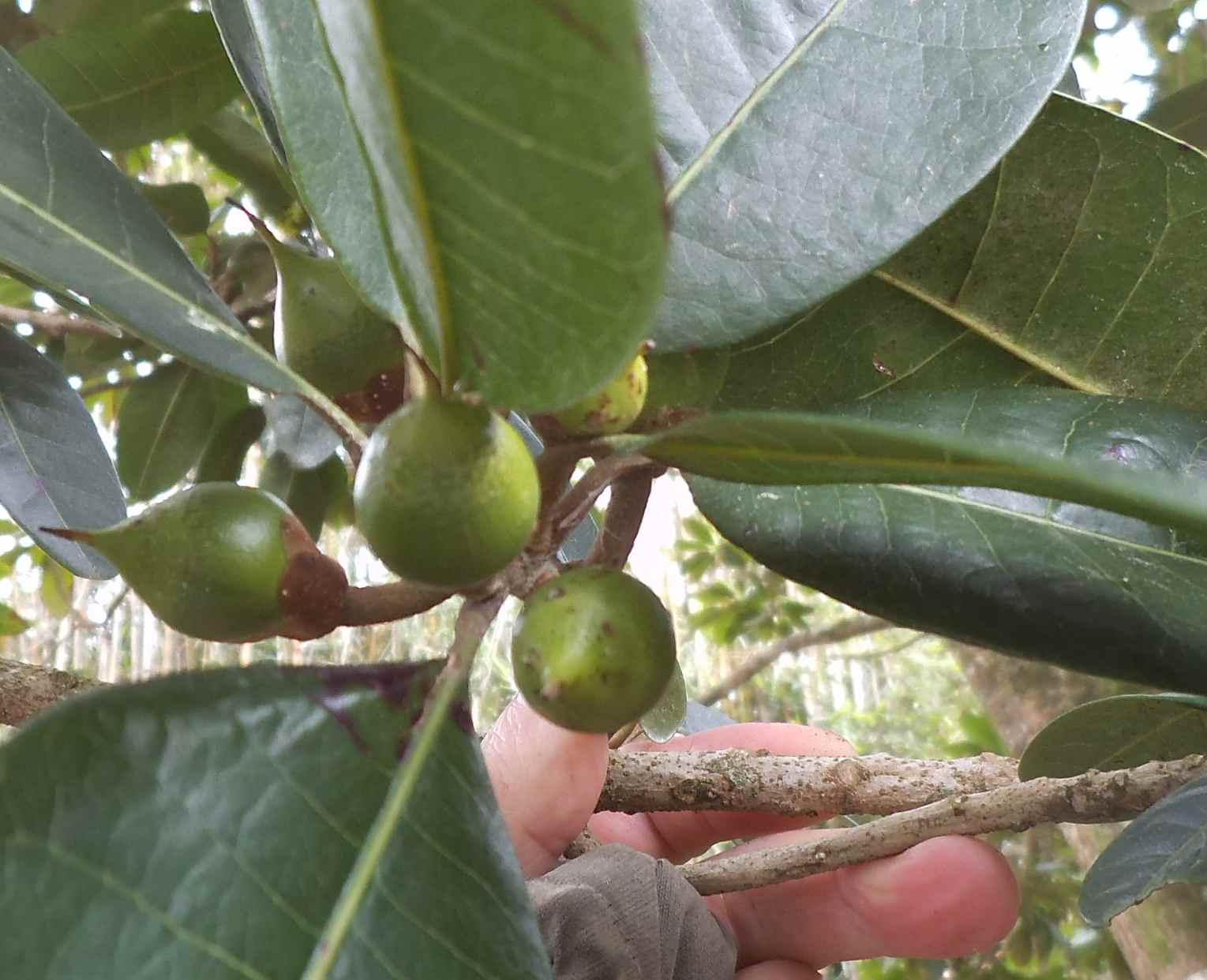 In South America, there are selections with a
softer flesh, and these types are known variously as as 'silk'
('seda' in Spanish) or 'smooth' types [2],. These are sometimes
known as 'Biotype I' [12] The 'silk' type tree is the predominant
form in Chile. These types have been described as "sweet and creamy"
[3]. The brix (sugar/soluble solids) levels in the silk types are very
high - around 28 Brix. Skin color is green toning lighter to yellowish,
and in others it verges on orange. Most of the seedling selections
('biotypes') for fresh market are smaller fruit, and have a very strong
butterscotch or maple syrup flavor. There is little or no astringency
in the flesh near full maturity The flavor is marked and intense,
even in fruit that are not fully mature. This flavor is the
reason so many people rave about the lucuma. The solitary Chilean tree
I have here fits this description. This fruit is the ideal fresh market
fruit. The ideal fruit is described as having either yellow or orange
flesh of a smooth consistency, high sugar levels, moderately intense
aroma, and a high pulp yield..[7] The best Chilean 'biotypes' have only
1 seed. The Chilean seedling I have here has 3 seed, and the fruit wall is
rather thin (see the photo above).
In South America, there are selections with a
softer flesh, and these types are known variously as as 'silk'
('seda' in Spanish) or 'smooth' types [2],. These are sometimes
known as 'Biotype I' [12] The 'silk' type tree is the predominant
form in Chile. These types have been described as "sweet and creamy"
[3]. The brix (sugar/soluble solids) levels in the silk types are very
high - around 28 Brix. Skin color is green toning lighter to yellowish,
and in others it verges on orange. Most of the seedling selections
('biotypes') for fresh market are smaller fruit, and have a very strong
butterscotch or maple syrup flavor. There is little or no astringency
in the flesh near full maturity The flavor is marked and intense,
even in fruit that are not fully mature. This flavor is the
reason so many people rave about the lucuma. The solitary Chilean tree
I have here fits this description. This fruit is the ideal fresh market
fruit. The ideal fruit is described as having either yellow or orange
flesh of a smooth consistency, high sugar levels, moderately intense
aroma, and a high pulp yield..[7] The best Chilean 'biotypes' have only
1 seed. The Chilean seedling I have here has 3 seed, and the fruit wall is
rather thin (see the photo above).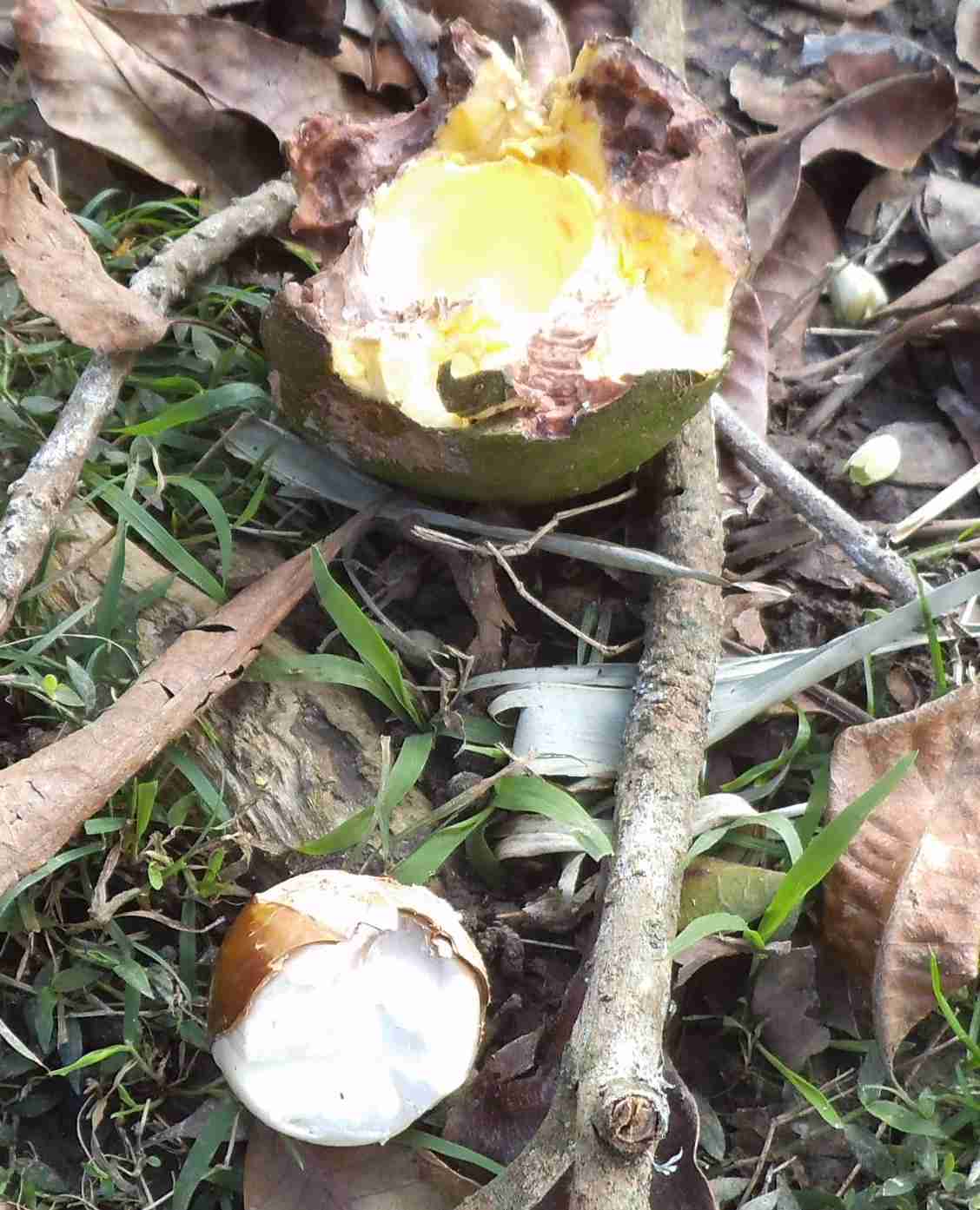
 Possums love the fruit. Indeed, when several
trees are maturing fruit at the same time, they will selectively focus
on their 'favorite'.
Possums love the fruit. Indeed, when several
trees are maturing fruit at the same time, they will selectively focus
on their 'favorite'. It has been noted in the literature that dogs eat the fruit, and this has been borne out in New Zealand, where all fruit within reach have been picked and eaten by the family pet!
Sheep also eat them, and seem to also enjoy eating the seeds.
Sheep eat both the seeds and pulp of lucuma
Curiously, the seed contains about 2.5% of an oil comprising a mix of fatty acids that have been found to promote healing and reduce inflammation in wounds and other damage to the skin. The fatty acids comprise roughly 39% linoleic (C18:2), 28% oleic (C18:l), 19% palmitic (C16:0), 9% stearic (C18:0), 3% γ-linolenic acid (C18:3, gamma linolenic acid, GLA) and 0.61 arachidic acid C20:0. There are small, or extremely small, amounts of myristic, pentadecanoic, palmitoleic, decanoic, heptadecanoic, lauric, behenic, eicosadienoic, erucic, heneicosanoic, docosadienoic, lignoceric, octanoic, and eicosapentoic fatty acids.There are also very small amounts of five other unidentified fatty acids. [4]
The wound healing characteristics of lucuma oil is not dissimilar from the wound and skin healing properties of avocado oil. Avocado oil contains about 47.20% oleic acid, 23.% palmitic acid, 13.% linoleic acid, 9% cis-13, 16-docosadienoic acid (C22 : 2), 3.58% palmitoleic acid (C16 : 1), 1.50% linolenic acid (C18 : 3n3), 1.3%) cis-11-eicosenoic acid (C20 : 1), and 0.33% myristic acid (C14 : 0). Linoleic (high levels in lucuma seed oil) and oleic acid (high levels in avocado and olive oil) modulate skin inflammation and thereby assist healing. Avocado contain around 20% oil in the flesh, and it is a lot easier to extract.
The big challenge is to know when the fruit are ripe. They are certainly ripe when they fall from the tree and split. Of course, at that point they are subject to possum, rat, dog, and sheep damage. It would be better to pick them at 'just the right stage' so that they will ripen properly off the tree. Much like an avocado fruit.
Fruit maturity and ripening
The fruit are usually well-sized on the tress by mid april. June-july-august is lucuma fruit season here. Some years fruit starts to fall in june, some years it is late june and july and into august and early September. Individual trees differ from each other in ripening date. Some start in june, some don't mature fruit until spring. And it can vary by year, as well. In one year, a tree didn't start to color slightly on the tree and then fall until november. To make life even more difficult, many trees have a relatively long flowering and fruit set period. This means that there are fruit on the tree at different stages of maturity, and the fruit ripens and falls sporadically over time. In 2013 most trees had the better part of the crop on the tree at late august. In 2014 the fruit of the Ecuadorean trees ripened over the winter months of june july august. The Chilean seedling ripened its fruit from july onward. These trees are a bit of a puzzle.
Fruit that fall naturally are generally ripe, or near ripe. This is similar to avocado fruit, which also detach from the stalk and fall from the tree to the ground when dead ripe. Some fruit split when ripe, some don't. If you pick the fruit from the tree, it may 'bleed' a little sticky white latex from where it was attached to the stem. In South America, apart from time of year, maturity is judged by skin color turning slightly yellowish (although not all fruit show this change), a slight softening when the fruit is pressed hard with the fingers, and the ease with which the fruit will detach from the stem [2]. It is recognized in South America that fruit that are picked too early will wrinkle, be "astringent", and simply fail to soften. The problem of finding trees that ripen their fruit crop evenly is one that still exercises South American researchers minds.[7] Some fruit - notably Chilean 'seda' types - have much less or no astringency when they are close to maturity but still firm. You can bite into the firm fruit with impunity, and eat it like an apple. These types have no bitterness in the skin, so the skin can be eaten as well - although it is a bit thick and obtrusive.
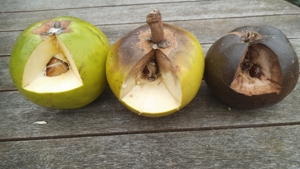 Ecuadorian 'palo' fruit picked too early simply
don't soften, but ultimately become discoloured and 'off'. Picked
closer to the correct time (but still a bit too early) and the skin
will change from green to a light lemon yellow. At this stage the flesh
will soften, but it will not become mealy in texture. The flesh color
will remain creamy white, and the flesh strongly astringent and without
sweetness. Eventually the skin and flesh discolor to a murky brown.
Ecuadorian 'palo' fruit picked too early simply
don't soften, but ultimately become discoloured and 'off'. Picked
closer to the correct time (but still a bit too early) and the skin
will change from green to a light lemon yellow. At this stage the flesh
will soften, but it will not become mealy in texture. The flesh color
will remain creamy white, and the flesh strongly astringent and without
sweetness. Eventually the skin and flesh discolor to a murky brown.The photos on the left illustrate the progression of these deceptively 'apparently mature' fruit.
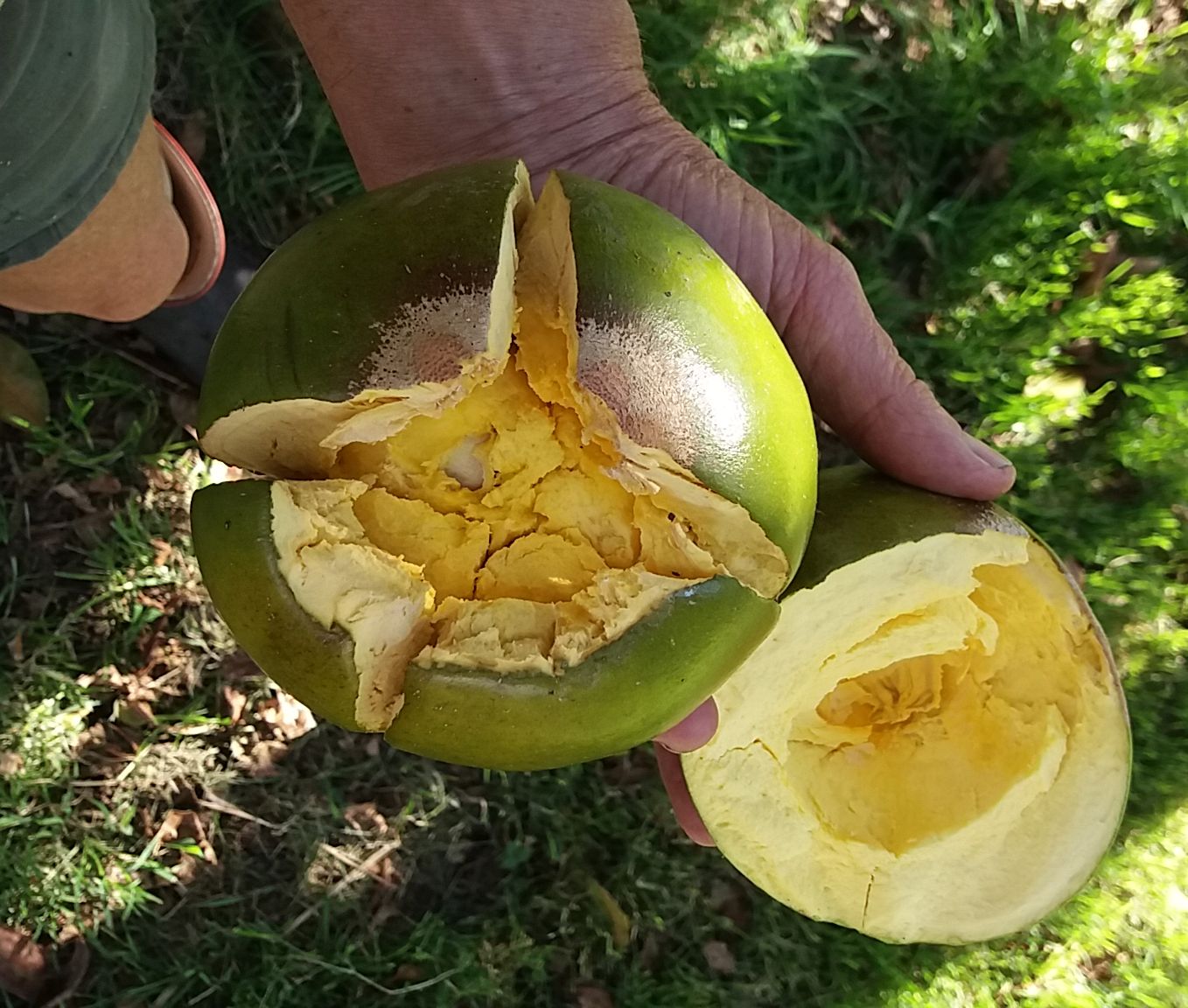 Picked at the correct stage of maturity, they will ripen at room
temperature after 5 to 9 days. We put them in a plastic bag to
concentrate any fruit-ripening ethylene gas they may be producing. They
tend to 'sweat' quite a bit, but don't rot. The literature says that
post harvest ripening is assisted by enclosing the fruit in paper
bags.[2].Chilean seda fruit turn a slight khaki green and develop a
strong aroma when they are ripe. [Annemarie Endt, pers. comm 2013].
Picked at the correct stage of maturity, they will ripen at room
temperature after 5 to 9 days. We put them in a plastic bag to
concentrate any fruit-ripening ethylene gas they may be producing. They
tend to 'sweat' quite a bit, but don't rot. The literature says that
post harvest ripening is assisted by enclosing the fruit in paper
bags.[2].Chilean seda fruit turn a slight khaki green and develop a
strong aroma when they are ripe. [Annemarie Endt, pers. comm 2013].Fruit will keep for 2 - 3 weeks at 15 to 18oC, but temperatures below this range affect quality, albeit ripening fruit can be kept for 2 - 3 days at refrigeration temperatures without significant effect [2].
The trees drop their fruit naturally when they are mature - but, again, this varies with tree and season. The fruit from some trees splits open naturally.
Left - naturally fallen and split open ripe 'palo' fruit (October 2018).
We put them in the 'too hard' category, and leave them for the sheep. The sheep eat them no matter how unripe they are. Seems a shame, as they are fairly productive - unless affected by Phytopthora root rot.
Uses
The short YouTube clips below traverse the common commercial uses - frozen pulp is used in yoghurts, ice-cream. and smoothies. The pulp is dried and milled into a flour, which has myriad uses - baked goods, food flavoring, that sort of thing.
Chile has also traditionally made a lucuma paste, which has a rather date-like flavor. This is not frozen, and is sold in sealed plastic bags. It is used as a filling in puddings and the like. [Annemarie Endt, pers. comm 2013].
In the home situation, the flesh can be scooped out of the ripe fruit and used immediately in smoothies and the like. The flesh can also be cut into small pieces and frozen in shallow plastic containers for later use. It retains its form, and is easy to cut sections off, not forming an "unmanageable mass" [Annemarie Endt, pers. comm 2013].
Commercially, the 'Palo' fruit can be dried at anything from 50oC to 70oC in forced air driers in slices anything from 2mm to 4mm thick. The 'Seda' fruit retain their flesh color best when dried at 50oC and when sliced into no more than 2mm thick pieces. While both biotypes have a yellow caretonoid, the 'seda' biotype has either a more intense red caretenoid, or greater concentrations of it; in any case, it results in the orange color of the flesh.[12]
Nutritional composition
According to 'The Lucuma' (and Google translate!), lucuma fruit have a relatively high protein content of 1.5% to 2.4% by weight. The flesh contains 25 grams of carbohydrate per 100 grams. The sugar component of the carbohydrates are 8.4 grams of glucose, 4.7 grams of fructose, 1.7 grams of sucrose, and 0.06 grams of inositol. Prior to maturity, there is only sucrose present, and this is gradually converted to other sugars in the process of ripening.
On a per 100 gram fresh pulp basis, lucuma fruit have about 2.3mg of carotene, about 2mg of niacin, 0.14 grams riboflavin (B2), and 0.01 grams thiamine (B1). Lucuma fruit have over three times the amount of niacin than apples (for example) have, but significantly less of the other B vitamins than apple.
Lucuma fruit contain trivial amounts of vitamin C, about 2.2 milligrams. (A mango, for comparison has around 63 to 158 mg per 100 grams of pulp, depending on variety.)
Like banana, lucuma has relatively high values for dietary fibre, mainly insoluble dieatary fibre [11].
Propagation
Seed propagation
Seedling trees are available from time to time from garden centres and from specialist nurseries such as Edible Gardens in Kumeu, Auckland. My Ecuadorian seedlings, introduced in 1982, did not commence fruiting until 1994, a period of 12 years. However, these are Ecuadorian seed, are unselected, and the trees are growing in unfavorable conditions. Others who have grown the plant from seed outside its native environment also report a 12 to 15 year period before the first flowering, then two years to the first fruit set.[6] Fresh seeds germinate in about a week or so, and the shoot generally appears about 2 weeks later. It can take as long as 3 months for a shoot to emerge. The more mature the seed, the faster the germination (all else equal). The seed loses viability if it dries out, so should be sown as near fresh as possible. Some claim germination is faster if the shiny hard seed coat is removed.
Graft propagation
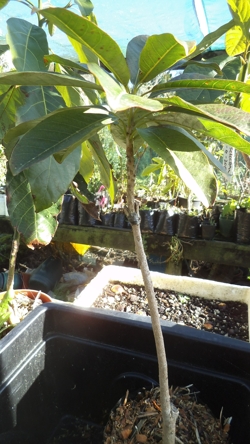 Experience in New Zealand from Government cultivar introductions in the
1980's is that grafted plants will commence flowering in around 4-5
years from planting out in fertile, well drained soils. The
grafted plants at LandsEndt commenced fruiting 5 years after planting
out, and the literature says that some grafted plants start fruiting in
the 5th year, but reliable fruiting only starts after the 6th year.
.This is still better than seedlings. There are no recognized
rootstocks, so any seedling lucuma is used. If you
have access to scionwood of good types, you can try grafting it to
seedlings. Seedlings should be about pencil thickness, which might take
around 8 months or so from planting seeds.
Experience in New Zealand from Government cultivar introductions in the
1980's is that grafted plants will commence flowering in around 4-5
years from planting out in fertile, well drained soils. The
grafted plants at LandsEndt commenced fruiting 5 years after planting
out, and the literature says that some grafted plants start fruiting in
the 5th year, but reliable fruiting only starts after the 6th year.
.This is still better than seedlings. There are no recognized
rootstocks, so any seedling lucuma is used. If you
have access to scionwood of good types, you can try grafting it to
seedlings. Seedlings should be about pencil thickness, which might take
around 8 months or so from planting seeds.I tried some simple terminal 'wedge' grafts in summer (late december), and of the 5 attempts, 1 succeeded. The graft union is not very good, but the tree is 8 months old now (2013), and seems OK.
Scionwood bleeds a sticky white latex when it is cut from the tree. I washed it off best I could before grafting. Whether this is the 'right' thing to do or not, I don't know. There are some hints that at a certain time of year the sap doesn't flow as strongly, and this is the best time to graft. Sadly, there is no mention of when that time would be! Grafting in winter (July), when wood is is mature has been successful provided it is done in greenhouse conditions [B. King pers. comm 2014].
If the winter is warm (as 2014 is) seedling lucuma growing outside in planter bags may start new terminal growth in mid july. This might fit nicely with mid winter grafting, especially if newly grafted plants can be given some protection, even is not full glasshouse conditions.
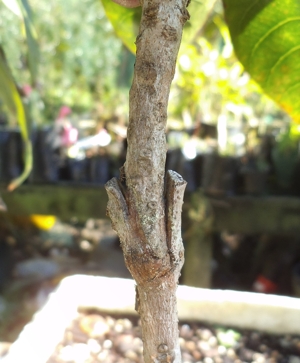
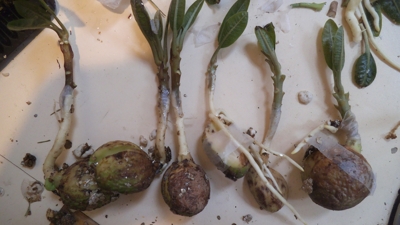 There is
a method (Gardiazabal and Valenzuela 1984) of grafting "cuttings" onto
the long emerging root of germinating lucuma seeds, but details
are scant. The principle is to germinate the seeds, cut off the thick
white root, split it, and place a wedge of a tip of the chosen variety
into the slit made in the root.
There is
a method (Gardiazabal and Valenzuela 1984) of grafting "cuttings" onto
the long emerging root of germinating lucuma seeds, but details
are scant. The principle is to germinate the seeds, cut off the thick
white root, split it, and place a wedge of a tip of the chosen variety
into the slit made in the root. The seed is then re-potted 'upside down' so the root with the branch tip is sticking up in the air. Any little laterals coming off the base of the thick main root are buried, as are other subsidiary roots, although these may need to be taped so they change direction to point to the 'new down'.
I grafted the seeds on the left about September, and left them enclosed in a plastic bag in damp vermiculite. Every terminal scion succumbed to fungal infection, but almost every single one had made a strong union with the root within 2 weeks. The technique seems promising, so long as fungi are controlled in the humid conditions.
Cutting propagation
The literature also refers to propagation by both cuttings and by marcottage. Cutting grown trees of 'Molina' were very briefly available from a specialist nursery, but I have never seen them on offer again. Pity. My little tree of 'Molina' was crushed within its chicken wire protective sleeve by a malevolent sheep.
"Up to" 80% rooting of terminal leafy cuttings has been obtained under mist when the cuttings were treated with NAA plant rooting hormone at the rate of 4,000 to 8,000 ppm [10]. Another report from this researcher in 1992 described taking terminal leafy cuttings from actively growing branches, treating them with 4,000 ppm of NAA, and placing them in a mix of equal parts of sand, peat, and styrofoam chips in wooden trays. The cuttings did not have mist, but were fully enclosed in a polythene 'tent' and put in 50% shade. Rooting started after 50 days, and the ultimate 'strike rate' was around 80%.
Cultivation
Grafted trees can be planted out once they have made 10 cms growth and have at least 6 leaves. They are planted out at roughly 5 meter by 5 meter spacings.Trees are usually trained to a vase shape. The form of the tree is shaped by pruning the young tree at 1 meter high to promote lateral branches. .Three or four branches arising at different heights on the trunk are chosen to form the base of the vase. In the second year the primary scaffold branches are pruned back to 40 to 50 cms to balance the tree. Inward growing branches are removed to open the tree out, and any suckers sprouting from the base of the tree are removed.[13]
Production from grafted plants hits its maximum at about 10 years, when up to 300 fruit per tree may be produced.[13]
YouTube clips
http://youtu.be/pUyTe-mFPO8 - Cultivar orchard
http://youtu.be/Pl311cBP6l4 - Puruvian organic orchard (english language)
http://youtu.be/OjyN3cDwzpo - Quick overview of the whole lucuma scene, from trees, plantations, variabilitiy in fruit, to uses in smoothies, pastry, ice cream, yoghurt. Spanish language.
http://youtu.be/uyGTCmRCj3w - lucuma fruit growing in upland Andes for powder production - good images of the fruit interior. English.
http://youtu.be/lswghTGM5kc - pruning a commercial lucuma orchard (Peru). Spanish.
References
1. 'Pouteria lucuma'. Wikipedia. Accessed 11/07/2013
http://en.wikipedia.org/wiki/Pouteria_lucuma
2. Unknown title: Chapter 1: The Lucuma. Date unknown.
http://www.biblioteca.udep.edu.pe/bibvirudep/tesis/pdf/1_161_186_112_1548.pdf
3. Lucuma. Fruitipedia. Accessed 11/07/2013
http://www.fruitipedia.com/lucuma_pouteria_obovata.htm
4.
https://www.google.com/patents/WO2010056908A1?cl=en&dq=lucuma+Pouteria&hl=en&sa=X&ei=zJEIUoLhEsbSkAX0yYCgBw&ved=0CDYQ6AEwAA
5. Janick, J., Paull, R.E. 2008. The Encyclopedia of Fruit & Nuts.
Cabi Publishing, Wallingford, UK
6. http://mundani-garden.blogspot.co.nz/2012/02/lucumo-of-peru-gift-from-andes.html
7. 'Perfil de Mercado y Competitividad Exportadora de la Lúcuma' Accessed 20/08/2013
http://www.mincetur.gob.pe/comercio/otros/penx/pdfs/Lucuma.pdf
8. Endt, D, 'Lucuma - a little known fruit from the Andes'.1985
Southern Horticulture, August 1985, pp23-24.
9. 'Field Trials near for sub-tropical lucuma'. 1986.
Reprint from Bay of Plenty Times in the june 1986 'Commercial Horticulture' journal
10. Odilo Duarte, B. and Rafael Franciosi, T. 1976. 'Recent advances in the propagation of some tropical and subtropical fruit species in Peru'
Acta Hort. (ISHS) 57:15-20
http://www.actahort.org/books/57/57_1.htm
11. Glorio, P., Repo-Carrasco, R., Velezmoro C. 2008. Fibra dietaria en variedades peruanas de frutas, tubérculos, cereales y leguminosas
Rev. Soc. Quím. Perú v.74 n.1 Lima ene./mar. 2008
http://www.scielo.org.pe/scielo.php?pid=S1810-634X2008000100006&script=sci_arttext
12. Inga, M, Velezmoro, C. 2004. 'Optimization of the dehydration process for twi biotypes of lucuma (Pouteria lúcuma (R & P) Kuntze) using the response surface methodology.' - Accessed 4 September 2013
Drying 2004 – Proceedings of the 14th International Drying Symposium (IDS 2004) São Paulo, Brazil, 22-25 August 2004, vol. C, pp. 1804-1811
http://www.feq.unicamp.br/~ids2004/volC/pp%201804-1811.pdf
13. Lucuma (Pouteria lucuma) - accessed 4th September 2013
http://agronomoglobal.blogspot.co.nz/2011/12/lucuma-pouteria-lucuma.html
14. Long, Owen, et al. History of the NZ Tree Crops Association (Inc). 1997
http://treecrops.org.nz/knowl/addgen/histOwenLong.html